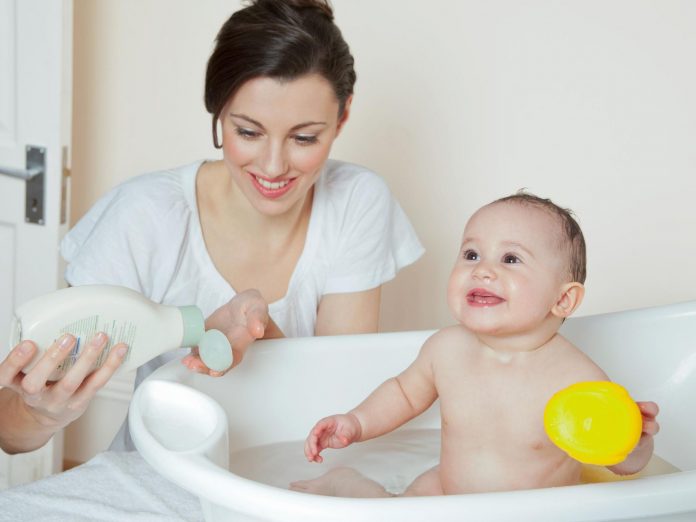It’s very important to remember that all babies might look dirty right after they are born, but that’s just the amniotic fluid that helped them survive during pregnancy. The nurses at the hospital clean up the baby, and if you ask, they will also show you how to properly and safely sponge bathe the baby. You should exclusively sponge bathe the baby until the umbilical stump dries and falls off naturally in the first month after birth. You will need the following things for a sponge bath:
- A soft, clean washcloth Cotton balls
- A mild, unscented baby soap and shampoo
- Soft towels
- Clean diaper
- Fresh baby clothes
- A flat, clean surface
Here’s how to sponge bathe the baby safely:
- Make sure you have a clean and safe flat surface to bathe the baby.
- Ensure that the room is warm so that the baby doesn’t catch a cold.
- Fill a small tub or sink with clean and lukewarm water (check the temperature with your elbow).
- Place the tub right next to the flat surface where you plan to bathe your baby.
- Place a towel on the flat surface, place your baby there and undress him or her.
- Wipe the baby’s eyes first with a clean cotton ball dipped in water.
- Don’t use any soap.
- Clean the nose, face and ears next, and gently pat the face dry with a soft, dry cloth.
- Now use mild baby soap and water to clean the baby’s body, paying special attention to the areas under the arms, behind the ears, and creases.
- Make sure you clean the baby’s genitals properly by going front to back, especially if you have a baby girl.
Once your baby is ready for a tub bath, you can give him or her a bath twice or thrice a week for the duration of the first year. Here are a few things you should remember while bathing your baby in the tub:
- Make sure the bath is brief and gentle, especially in the beginning.
- Bathe your baby in a warm room instead of the bathroom.
- Make sure the bath water is lukewarm and never hot.
- You must hold your baby upright and support his or her head, neck and back properly.
- Always place the baby feet-in first.
- Talk or sing to the baby continuously to soothe him or her.
- Make sure soap or shampoo water or suds do not reach your baby’s eyes and nose.
- Always start the bath with the face and head, and follow through to the rest of the body.
- Do not skip cleaning the genitals properly during baths.
- Wrap your baby with a clean and dry soft towel immediately after the bath to make sure he or she doesn’t catch a cold.
- Never leave the baby alone in the tub. If you need to leave the area in the middle of a bath, wrap your baby snugly in a clean towel and take him or her along.
Cleaning your baby’s umbilical stump:
The umbilical cord is the way your baby received nutrition during the pregnancy, and once your baby is delivered, the cord is cut and clamped. This umbilical stump usually dries and falls off naturally within four weeks. But until it does, it’s very important to care for your baby’s umbilical stump. Here are a few things you should remember:
- The stump should be clean, dry and healed properly.
- Do not use any soap, water or rubbing alcohol to clean the umbilical stump.
- Do not give the baby a tub bath until the umbilical stump falls off naturally.
- Do not try to poke or pull off the stump to help the falling off. It should happen naturally.
- Always place the baby’s diaper well below the stump to avoid moisture and infection.
- If the baby’s navel area looks red, develops a rash or smells foul, consult your paediatrician immediately.
It’s a good practice to preserve the baby’s umbilical stump once it falls off, since it has stem cells and blood which can later be used to treat the baby in case of diseases like sickle-cell disease, leukaemia, or metabolic disorders like Wilson’s disease etc.




























